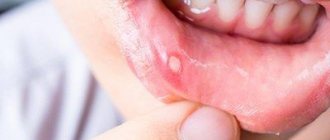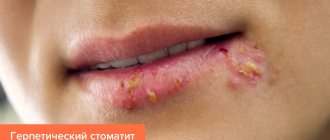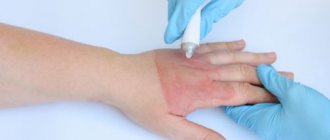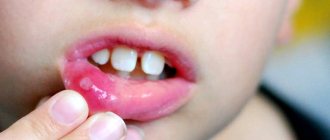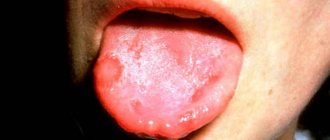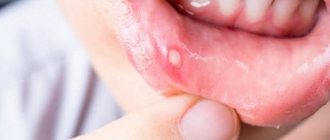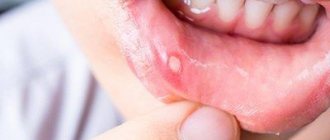September 9, 2022 Stomatitis is rarely perceived as a serious disease. But the symptoms of this disease indicate otherwise. Pain that worsens with every movement of the lips and tongue, the inability to chew food and sleep disturbances caused by burning and discomfort in the mouth make stomatitis more than a serious problem for those who experience it. But the complications of this disease are no less dangerous. Infection and inflammation left untreated can quickly spread to the mucous membrane of the tonsils, pharynx, and larynx and lead to even more serious illnesses. The listed circumstances are enough to understand: at the first signs of stomatitis, treatment should begin, which should be comprehensive and take into account all aspects of the disease and the patient’s needs.
General approaches to the treatment of childhood stomatitis
A child who experiences any symptoms of the disease must contact a specialist. It is almost impossible to cure stomatitis on your own, and delaying treatment can cause serious complications, both in newborns and older children.
- It is advisable to isolate a sick child from using common household items in the family. It is worth providing him with separate dishes, cutlery and towels. If there are other children in the family, then it is necessary to minimize contact through shared toys.
- Strict oral hygiene is recommended to prevent secondary infection and worsening of the disease. For example, a child under one year old should treat the oral mucosa with special wipes with xylitol or another antiseptic. Children over one year of age can rinse their mouths with antiseptic solutions before and after meals. To clean your teeth, you should purchase a toothbrush with soft bristles that will not injure the inflamed surface of your gums or tongue.
- When stomatitis occurs in newborns or infants, special attention is paid to the treatment of nipples, feeding bottles, pacifiers and nipples of the mother's mammary glands.
- Eating any food usually brings severe pain to the child. To reduce sensitivity, anesthetic gels and sprays are used.
- Particular attention in the effective treatment of stomatitis is given to nutrition. The food you eat should be at body temperature. All irritating, sour and spicy foods are excluded from the diet. In case of severe pain, you can offer the child to eat homogenized liquid food through a wide tube. Nutrition should be balanced and contain sufficient amounts of nutrients, as well as vitamins and minerals.
For stomatitis, Dr. Komarovsky recommends paying special attention to the microclimate of the room in which the sick baby is located. The room must be well ventilated twice a day. In winter, the air must be humidified using special humidifiers.
Medicines for stomatitis in children: how to treat?
Selecting the right children's medicine for the medical treatment of stomatitis is a rather delicate process. After all, at different ages, children need to be treated differently: those drugs that are suitable for a one-month-old baby may not affect the course of the inflammatory process at all in a two-year-old child.
The same applies to the question of how long it is necessary to treat such a pathology. In infants, a one-year-old baby and a 2-year-old child, recovery times will also differ, even when using the same remedy. In any case, you should not expect quick treatment, since it takes several days to several weeks to relieve inflammatory reactions and heal damaged tissues.
Drug treatment
Drug treatment is aimed at relieving symptoms of stomatitis such as pain and inflammation, as well as accelerating the healing process of damaged tissue.
Painkillers
Since young children have a fairly low pain threshold, pain relief is the primary goal in the treatment of acute stomatitis. For this purpose, both system-wide drugs for oral administration and local agents in the form of gels are used.
Painkillers for oral administration:
- Ibuprofen is a strong drug that has a pronounced analgesic, anti-inflammatory and antipyretic effect. Its dosage is prescribed at the rate of up to 10 mg per kg of the child’s weight three times a day for no more than 5 days in a row. Can be used no earlier than 3 months of age.
- Paracetamol also relieves pain and fights high fever. For children under three years of age, it is preferable to use rectal suppositories or syrup, while older children can use tablets. The dosage is calculated based on the child’s weight (15 mg per kilogram). It is possible to use the product 3-4 times a day.
Local anesthetics:
- Cholisal is a drug with a good analgesic effect, which additionally has anti-inflammatory and antibacterial effects. Apply the gel to damaged mucous membranes 3-4 times a day before or after meals, as well as before bed. It is not advisable to use before 9 months of age.
- Kamistad - a combination of lidocaine with chamomile infusion gives a good analgesic and anti-inflammatory effect. The gel should be used 3-4 times a day, rubbing it into the area of inflammation.
- Kalgel is a combined drug in the form of a gel with antimicrobial and analgesic effects. Well relieves pain from stomatitis, gingivitis and other inflammatory diseases in the oral cavity. Use no more than 6 times a day.
Antiseptic and anti-inflammatory agents
Drugs with antiseptic properties suppress the activity of pathogenic microorganisms and have a good anti-inflammatory effect. They can be used both for rinsing the entire oral cavity and for treating individual areas of damaged oral mucosa. They are successfully used to treat stomatitis at home.
Sprays for the treatment of stomatitis:
- Hexoral is a spray with pronounced activity against pathogenic microflora. Used after meals and remains effective for up to 12 hours. It is used twice a day by briefly spraying the solution in the mouth.
- Inhalipt is a combination drug that combines a soluble form of streptocide in combination with essential oils. It has anti-inflammatory, antiseptic and minor analgesic effects. Oral irrigation is carried out 3-4 times a day until the symptoms of stomatitis disappear.
- Chlorophyllipt is a spray with an antiseptic effect. Suppresses pathogenic microflora, promotes rapid healing of ulcers. Used to irrigate the oral cavity 2-3 times a day until recovery.
Iodine-based preparations:
- Lugol is an iodine-based drug with a pronounced t effect. Used as a spray for irrigating the oral cavity and in a solution for treating damaged areas of the mucous membranes. Treatment of the affected areas is carried out 2-3 times a day using a cotton swab or by spraying a spray.
- Iodinol is another iodine-based medicine. It has low toxicity and is destructive to most microorganisms and fungi. It is not used for stomatitis in children under one year of age, as there is a high risk of swallowing the drug. For children aged 1.5 years and older, it can be used as a mouth rinse (5 ml of solution is diluted in 50 ml of warm water). The procedure is carried out 4-5 times a day, no more than 5 days in a row.
Mouth rinse solutions:
- Stomatidin is a powerful antiseptic with a pronounced anti-inflammatory effect. Used for rinsing the mouth or treating damaged surfaces with an undiluted solution. The procedure is carried out 2-4 times a day, with an interval of at least 4 hours between them. The course of treatment usually lasts 7 days.
- Miramistin is a drug with a broad spectrum of action against pathogenic flora. It eliminates signs of inflammation well. It is used in the form of a solution, which is used to treat areas of stomatitis, or in the form of aerosols, which are applied to the entire oral cavity. The frequency of the procedure is 2-3 times, the duration of the course of treatment is 7 days.
- Chlorhexidine is a solution with an antiseptic effect. Suppresses the growth of pathogenic bacteria and helps the body fight inflammation. Children over 7 months of age can treat the oral cavity with a solution diluted with boiled water (the ratio of water to the drug is 1:1), children over 5 years old can rinse their mouth with a regular solution. Repeat the treatment procedure 2-4 times a day until the symptoms of stomatitis disappear.
- Furacilin is a fairly broad-spectrum antiseptic. Does not cause irritation to mucous membranes. Available in the form of a ready-made solution or tablets. To prepare the solution at home, you need to dissolve 1 tablet of furatsilin in 500 ml of warm boiled water. You need to rinse your mouth with this solution 3-4 times a day until complete recovery. For small children under 2 years of age, the drug can be applied with a gauze swab directly to the inflamed area.
- Hydrogen peroxide as an antiseptic can be used to treat stomatitis in older children. The use of such a product must be careful, since it is toxic and can cause serious burns to the mucous membranes. To prepare a rinse solution, dissolve 1 teaspoon of peroxide in 100 ml of water. Carry out the procedure three times a day after meals. The course of such treatment is 5-7 days.
- Stomatofit is a plant-based drug that has bactericidal, anti-inflammatory and tanning effects. To rinse the mouth, 10 ml of solution is mixed with a quarter glass of water. Treatment is carried out 3-4 times a day until complete recovery.
Anti-inflammatory and antiseptic gels:
- Metrogyl denta is a combined remedy for the treatment of inflammatory diseases of the oral cavity. The gel is applied to areas of the mucous membrane affected by stomatitis three times a day. The course of treatment is approximately 7 days.
Vitamin and regenerating products
Vitamins and wound-healing agents in the treatment of stomatitis are used after acute symptoms have subsided. Their main task is to speed up the regeneration processes in damaged tissues, maximally restore their metabolism and adequate blood supply. Such drugs are most often used topically in the form of oils, gels, and ointments.
The most commonly prescribed drugs are:
- Aekol is an oil solution of vitamins A, E, K and provitamin A. The product is applied directly to the affected area on a gauze bandage once every 48 hours. The treatment course continues until the mucous membrane is completely restored.
- Vinilin - has an anti-inflammatory effect and at the same time stimulates the healing of damage to the mucous membrane. Apply the drug using a cotton swab directly to the affected area after each meal and before bedtime until the clinical manifestations completely disappear. According to the instructions, it can be used after one year of age.
- Solcoseryl is a paste that stimulates the processes of epithelization of damaged tissues, promoting the rapid healing of ulcerative defects in stomatitis. For children, it is necessary to apply the drug 3-4 times a day after thoroughly rinsing the mouth with clean boiled water and drying the inflamed areas with sterile cotton pads.
- Sea buckthorn oil is a natural remedy that has a regenerating effect. After the acute symptoms have subsided, apply with a sterile cotton swab to the inflamed areas twice a day.
Frequent stomatitis. How to quickly cure stomatitis
Go back
Stomatitis is an inflammatory disease of the oral mucosa. Persistent stomatitis, regardless of the cause, indicates a decrease in immunity and, as a result, the development of inflammation.
Symptoms of stomatitis
Pain, burning, mouth ulcers, swelling of the tongue and lips, as well as other parts of the oral mucosa, are the most common symptoms of stomatitis. Pain with stomatitis can occur both when eating or talking, and at rest with severe inflammatory changes in the oral mucosa. Advanced or long-term untreated stomatitis can affect most of the oral mucosa. In such a situation, patients with stomatitis are hospitalized.
Cause of stomatitis
The oral mucosa is the body's first barrier when encountering an infection.
Whether we eat or drink water, talk or breathe, every time a large number of different microbes rush into our body through the mouth. Often the causes of stomatitis in adults and children come down to poor hygiene and lack of adequate oral care. One of the most common causes of stomatitis is infection. Moreover, this group can include bacteria, viruses, and fungi. How ORALSEPT helps ORALSEPT® affects the cause of inflammation (bacteria and fungi) and relieves the symptoms of inflammation.
Read more
Frequent stomatitis in adults. Causes There are many causes of stomatitis, which occurs several times during the year. As a rule, repeated episodes of stomatitis develop against the background of disruption of both local and general immunity.
The main causes of stomatitis are:
- Diseases of the gastrointestinal tract
- Intestinal infections
- Smoking
- Drinking alcohol and hot drinks
- Eating food with lots of spices
- Diabetes
- Acquired immunodeficiency syndrome (AIDS)
- Radiation therapy in the treatment of cancer
And this is not a complete list of factors leading to the development of stomatitis.
Frequent stomatitis in a child. Reasons “Don’t put it in your mouth” is one of the most common comments to a child. Children try to learn everything new by tasting it. This is how the infectious agent enters the oral cavity. Stomatitis in children can be a manifestation of both an independent disease - for example, herpes, and a symptom of other infections. Stomatitis often occurs with measles (Filatov's spots) and enterovirus infection, with chicken pox and other diseases. Also, stomatitis in children can often be a manifestation of an allergic reaction or the result of an intestinal infection. The first place among the infectious causes of stomatitis in children is occupied by herpetic and candidal stomatitis.
Herpetic stomatitis in children is characterized by severely painful ulcers in the mouth. The first episode of herpetic stomatitis can last quite a long time, up to 2-3 weeks, until the body forms protective antibodies to the virus. Children refuse to eat due to pain. The disease manifests itself not only with local symptoms, but also with general ones, such as weakness, fever, headache, nausea.
Candidal stomatitis in children can appear literally in the first months of life. With candidal stomatitis, a white, loose (curdled) coating appears on the oral mucosa. Beneath it, a red, swollen, inflamed mucous membrane is visible. The cause of candidal stomatitis is a decrease in immunity and a fungal infection (fungus of the Candida species), which, as a rule, develops due to disturbances in the gastrointestinal tract or food allergies. Infants with candidal stomatitis are very restless, often cry, and quickly lose weight.
How to quickly cure stomatitis The main complaint with stomatitis is pain. And therefore, first of all, drugs that reduce pain and have an anti-inflammatory effect are prescribed. These may be non-steroidal anti-inflammatory drugs, local anesthetics. It is also necessary to prescribe antimicrobial drugs that act on the main cause of stomatitis - infection.
How to quickly cure stomatitis in a child
To quickly relieve pain and inflammation during stomatitis, local remedies are used. But children often do not know how to rinse their mouths, and due to pain they may react negatively to the use of oral medications. In such a situation, using a topical treatment spray will help.
How to quickly cure stomatitis in an adult
Stomatitis in adults often affects general well-being.
In addition, people whose professional activities involve the active use of speech cannot fully perform their work when stomatitis occurs. In such a situation, either a temporary refusal to work for treatment or the use of drugs that quickly relieve pain and inflammation, and which can be taken with you and used on the go, is required. Remedy for stomatitis – what to choose? More recently, when treating stomatitis, doctors prescribed several drugs at the same time: for pain, inflammation, anti-infectives. It was a set consisting of gels, rinses, tablets for oral administration and topical use. Currently, in the treatment of stomatitis, agents are used that act directly on the site of inflammation and have a complex effect. Oralcept spray in such a situation is the best option. Acting locally on the source of inflammation, it quickly, within a minute*, reduces pain and reduces the inflammatory manifestations of stomatitis. In addition, it has a local antiseptic effect and fights bacterial and fungal infections. Oralcept has a pleasant, delicate mint taste. The compact plastic bottle of the drug with a special nozzle is convenient to carry with you.
*WITH. Simon-Savois, D. Forest. - "Local anesthetic activity of benzydamine", Modern Therapeutic Research, Vol. 23, No. 6, June 1978, Department of Dentistry, University of Montreal, Montreal, Canada
Table of children's medications against stomatitis by age
| Drug/Age | 1 month | 3 months | 4 months | 5 months | 7 months | 1 year | 2 years | 3 years | 5 years | 6 years | 10 years |
| Paracetamol | + | + | + | + | + | + | + | + | + | + | + |
| Soda | + | + | + | + | + | + | + | + | + | + | + |
| Candide | + | + | + | + | + | + | + | + | + | + | + |
| Viferon | + | + | + | + | + | + | + | + | + | + | + |
| Suprastin | + | + | + | + | + | + | + | + | + | + | + |
| Ibuprofen | — | + | + | + | + | + | + | + | + | + | + |
| Holisal | — | — | + | + | + | + | + | + | + | + | + |
| Kamistad | — | — | + | + | + | + | + | + | + | + | + |
| Parlazin | — | — | + | + | + | + | + | + | + | + | + |
| Kalgel | — | — | — | + | + | + | + | + | + | + | + |
| Chlorhexidine | — | — | — | — | + | + | + | + | + | + | + |
| Furacilin | — | — | — | — | + | + | + | + | + | + | + |
| Iodinol | — | — | — | — | — | + | + | + | + | + | + |
| Vinylin | — | — | — | — | — | + | + | + | + | + | + |
| Malavit | — | — | — | — | — | + | + | + | + | + | + |
| Fduconazole (Futsis) | — | — | — | — | — | + | + | + | + | + | + |
| Ingalipt | — | — | — | — | — | — | + | + | + | + | + |
| Honey | — | — | — | — | — | — | + | + | + | + | + |
| Propolis | — | — | — | — | — | — | + | + | + | + | + |
| Nystatin | — | — | — | — | — | — | + | + | + | + | + |
| Oxolinic ointment | — | — | — | — | — | — | + | + | + | + | + |
| Hexoral | — | — | — | — | — | — | — | + | + | + | + |
| Miramistin | — | — | — | — | — | — | — | + | + | + | + |
| Lugol | — | — | — | — | — | — | — | — | + | + | + |
| Stomatidin | — | — | — | — | — | — | — | — | + | + | + |
| Stomatophyte | — | — | — | — | — | — | — | — | — | + | + |
| Metrogil Denta | — | — | — | — | — | — | — | — | — | + | + |
| Hydrogen peroxide | — | — | — | — | — | — | — | — | — | — | + |
| Chlorophyllite | — | — | — | — | — | — | — | — | — | — | + |
| Aekol | — | — | — | — | — | — | — | — | — | — | + |
Treatment with folk remedies
Alternative treatment can be a good addition to the main therapeutic prescriptions. However, only a doctor should decide how and how much stomatitis is treated in a child.
Traditional methods are not recommended for very young children. It is better not to use them before the age of 2 in order to avoid the development of serious allergic reactions, which can only aggravate the underlying disease.
Often, beekeeping products are used in folk recipes for medicinal purposes for stomatitis: honey and propolis.
- Dissolve 2 teaspoons of natural honey in the prepared decoction of chamomile flowers (1 tablespoon per glass of boiling water). Rinse your mouth with a warm solution 3-4 times a day.
- Mix a tablespoon of fresh aloe leaves with the same amount of natural honey. Apply the resulting mixture 3 times a day to areas of inflammation using a sterile cotton swab.
- Dissolve 10 drops of propolis alcohol tincture in a full glass of warm boiled water and rinse your mouth thoroughly 3 times a day after meals.
Gargling with soda and salt has proven to be a good remedy for treating stomatitis, even in young children. To prepare the solution, you need to dissolve half a teaspoon of baking soda and salt in a glass of boiled and cooled water. Rinse your mouth 4-5 times a day, especially after eating. However, it should be remembered that it is not advisable for the soda-saline solution to come into contact with open wounds on the mucous membrane.
Traditional medicine often prescribes treating stomatitis in children with burnt alum, a powder prepared from heat-treated potassium alum. To prepare the remedy, half a teaspoon of powder is dissolved in a glass of warm water until a somewhat viscous solution is obtained. Older children can rinse their mouth with this product 3-4 times a day. For babies, you can treat the mucous membranes with a swab dipped in alum solution.
Treatment of inflammatory diseases of the oral cavity with herbs has proven itself well. For this purpose, decoctions of sage, calendula, chamomile, and oak bark are used. They have a pronounced antiseptic and astringent effect. It is recommended to rinse your mouth with such herbal decoctions at least 3-4 times a day.
Symptoms of stomatitis
- soreness of the oral cavity;
- bad breath;
- formation of ulcers in the mouth;
- increased body temperature (in severe and widespread form).
At the initial stage of stomatitis, the oral mucosa dries out in the affected areas and becomes shiny. After 1–2 days, a barely noticeable white coating appears. At the next stage of stomatitis, ulcers appear, which are called aphthae. The chronic form of stomatitis is diagnosed when several pathological lesions form in the oral cavity more often than once a year.
Homeopathic treatment
Many parents prefer to treat their children with homeopathy. However, such treatment should only be auxiliary and complement traditional methods.
In pediatric practice, the following drugs can be used:
- Borax,
- Mercuriussublimatuscorrosives,
- Natrum muriaticum,
- Arsenicum.
The group of homeopathic medicines also includes the combination remedy Malavit, which combines homeopathic components, natural herbal extracts and water from artesian springs. For rinsing with stomatitis, a solution is prepared from 5 drops of the drug and 100 ml of water (children under 5 years old need only one drop per year of life). The procedure is carried out 3-5 times a day after meals.
Features of the treatment of some forms of stomatitis
In addition to the use of antiseptic, analgesic, anti-inflammatory and wound-healing agents, various forms of stomatitis may require the use of other drugs that will act directly on the cause of the disease.
Bacterial stomatitis
For bacterial stomatitis, in addition to general treatment measures, the use of antibacterial agents is most often indicated. Which antibiotics should be taken is decided only by the attending doctor, who prescribes the drug depending on the clinical manifestations, the age of the small patient and examination data.
Candidal or fungal stomatitis
For fungi of the genus Candida, an alkaline environment is destructive, therefore, when treating candidal stomatitis, maximum alkalization of the oral cavity is achieved. In young children, for this purpose, you can use a solution of baking soda (1 teaspoon per small glass of water), which I treat the mucous membranes with twice a day.
In severe cases, the use of antifungal drugs is indicated:
- Candida for the oral cavity is a solution based on clotrimazole. Apply to inflamed areas 2-3 times a day. The course of treatment is 7-10 days, which cannot be interrupted due to the high risk of relapse.
- Nystatin is a drug with a pronounced antifungal effect. It is used in the form of a solution (prepared by dissolving tablets in warm boiled water) or cream. Apply to the affected areas 2 times a day.
- Fluconazole (Fucis) is a tablet form of an antifungal drug that can be used to treat severe forms of candidal stomatitis. In children, the dose is up to 12 mg per kg of body weight per day. The duration of treatment is determined by the severity of the condition.
Infectious (herpetic) stomatitis
Since the cause of the development of herpetic stomatitis is the herpes virus, if it occurs, the child is advised to use antiviral drugs.
- Oxolinic ointment - oxolinum shows high effectiveness against the herpes simplex virus. For herpetic stomatitis, it is necessary to apply the ointment 1-2 times a day to the area of the rash.
- Acyclovir is an antiviral agent. Prescribed to children with severe forms of herpetic stomatitis. The pediatric dosage is 100 mg 5 times a day for 5 days. Intravenous use is possible for infants. Applying 5% ointment or cream to the mucous membranes of a child is undesirable, as this may cause an increase in the inflammatory reaction.
- Viferon is a drug that has antiviral and immunostimulating effects. In pediatric practice, it is used in the form of rectal suppositories (twice a day), or as an ointment for the treatment of herpetic infections of the skin and mucous membranes (applied 2-3 times a day).
Ulcerative stomatitis
Often ulcerative stomatitis appears against the background of other diseases. Therefore, treatment is carried out specifically for the underlying disease. If the cause is poor oral hygiene, then the first step is to teach proper dental care.
If the causes are pathologies of the gastrointestinal tract, endocrine or immune system, then correction of these disorders is necessary.
Local treatment measures will include adequate pain relief, the use of antiseptics to prevent additional infection, and wound-healing medications.
Allergic stomatitis
Treatment of allergic stomatitis comes down to identifying a possible allergen, eliminating its influence and using antihistamines:
- Parlazin is a long-acting antiallergic drop. For children from three months of age to one year, the dosage is 3 potassium 1-2 times a day, over a year - 5 drops.
- Suprastin is an antihistamine that can be used in pediatric practice. Children under one year old can use 10 mg of the drug (a quarter of a tablet). After a year, the dosage is increased to 20 mg (half a tablet) 2 times a day.
At the same time, the child must be provided with hypoallergenic food and avoid contact with household chemicals and pets.
Traumatic stomatitis
In case of traumatic stomatitis, it is necessary to limit the oral cavity as much as possible from the effects of irritating food and food. It is imperative to carry out complete pain relief and use anti-inflammatory and wound-healing agents. If necessary, a course of antibiotics is prescribed.
What is stomatitis? Causes, symptoms, treatment of the disease
Stomatitis is an inflammation of the mucous membrane in the oral cavity. In one form or another, almost every person, starting with infants, has suffered from this disease at least once in their life. The disease can last from 4 days to 2 weeks, depending on the severity and effectiveness of treatment. Effective treatment of stomatitis at home is also possible, but not every form of this disease. If the disease is left to take its course, complications are likely.
Causes of stomatitis and its types
There are certain types of stomatitis, which differ precisely in the causes of the disease:
- fungal - caused by a special fungus Candida albicans and is considered a contagious disease; accordingly, the cause of the disease may be contact with an already sick person or poor oral hygiene;
- aphthous - caused by a lack of essential vitamins and minerals in the body, especially iron and vitamin B 12;
- herpetic - it is provoked by the herpes virus, it is also contagious, the cause is contact with the skin or lips of the patient;
- occurring after external influences - inflammation of the oral mucosa, like stomatitis in adults, often appears due to improperly selected dentures, as a result of frequent alcohol consumption and smoking.
- allergic - this type of stomatitis often occurs after taking certain medications, especially in large quantities;
- which is a reaction to prolonged administration or use of antibiotics that destroy beneficial microorganisms in the oral cavity, it becomes unprotected from any type of bacteria and viruses.
Sometimes the cause of stomatitis can even be low-quality toothpaste, some components of which can irritate the mucous membrane.
Stomatitis
Symptoms
Each type of stomatitis has common symptoms, but may differ in some ways:
- usually the disease begins with slight redness;
- later, the affected areas begin to itch and hurt;
- in advanced cases, bubbles form that can burst;
- fungal stomatitis has a characteristic white coating, especially in infants;
- herpetic stomatitis is expressed in characteristic rashes on the lips, sometimes large and painful;
- if the disease is not treated, it can progress to inflammation in the facial area.
Sometimes stomatitis can be one of the signs of other diseases, such as diabetes.
IMPORTANT! Stomatitis never causes fever, blood pressure, or stomach upset. These symptoms already indicate another concomitant disease, often more serious.
In infants, a symptom of stomatitis may be refusal to feed or unreasonable crying and general anxiety.
Treatment
If the disease is detected at an early stage, you can use proven home remedies. For example, rinse your mouth with a solution of hydrogen peroxide for several days; it is sold in every pharmacy. Only the peroxide itself should be diluted with water in a ratio of 1:5. Regular consumption of fresh yogurt, but without dyes, helps well - this procedure restores healthy microflora. Interestingly, regular consumption of garlic also helps healthy microflora and kills fungi and viruses.
Before deciding how to treat stomatitis, you need to determine what causes it. If antibiotics are used, success can be achieved by limiting their use. If this is an allergic reaction, remove the allergen and take antihistamines.
In cases where you have to deal with a viral or fungal infection, medications are used to treat stomatitis: antiviral ointments and antifungal agents: miramistin or hexoral.
Traditional medicine recommends rinsing the mouth with decoctions of calendula, St. John's wort or chamomile. As a protective agent for the mucous membrane, you can use sea buckthorn oil or ordinary petroleum jelly. Aloe juice is a good disinfectant for the oral cavity.
Prevention
To prevent the occurrence of this disease, you should follow certain simple rules:
- Maintain regular oral hygiene;
- do not abuse sweets and foods containing yeast;
- do not use antibiotics without a doctor’s prescription;
- Smoking and drinking less.
Do not forget about regular visits to the dentist; this often allows you to identify and prevent almost all possible diseases of the teeth and oral cavity.
What not to do with stomatitis
Often the older generation, when asked “how to treat your mouth for stomatitis?” Young mothers are advised to use alcohol solutions of brilliant green, blue, or fucorcin. It is believed that such products are good at disinfecting purulent wounds. However, this should not be done, since alcohol causes increased symptoms of inflammation and pain, which will negatively affect the child’s condition.
Another popular remedy against candidal stomatitis is borax in glycerin. The use of this product in childhood is also undesirable, since it contains quite toxic components, an overdose of which can cause significant harm to the baby’s health.
«
In the article we tried to provide the main means and methods of treating stomatitis in children. However, only a doctor can prescribe the correct treatment after examining the child. Delaying a visit to the doctor can cause serious complications and future health problems for the baby.
Features of using the spray for stomatitis
In addition to the complex action, Tantum® Verde spray for the treatment of stomatitis provides the following advantages:
Uniform spraying of the drug over the entire mucosal area
The droplet type of spraying of the drug is optimal for uniform application of the product to the surface of the mucous membrane. The spray also provides a wide spray angle - this allows you to cover the maximum area of the mucous membrane with a minimum number of injections1,2.
Frequency of use for stomatitis
Benzidamine in the aerosol provides a long-lasting effect, which reduces the frequency of use of Tantum® Verde while maintaining its symptomatic and therapeutic effect.
Be sure to take into account the need for proper use of the spray:
- the drug should be used only in accordance with the instructions and without exceeding the specified dosage;
- It is not recommended to use the spray for more than 7 days without consulting a doctor3;
- After using the spray, you should refrain from eating or drinking for some time.
